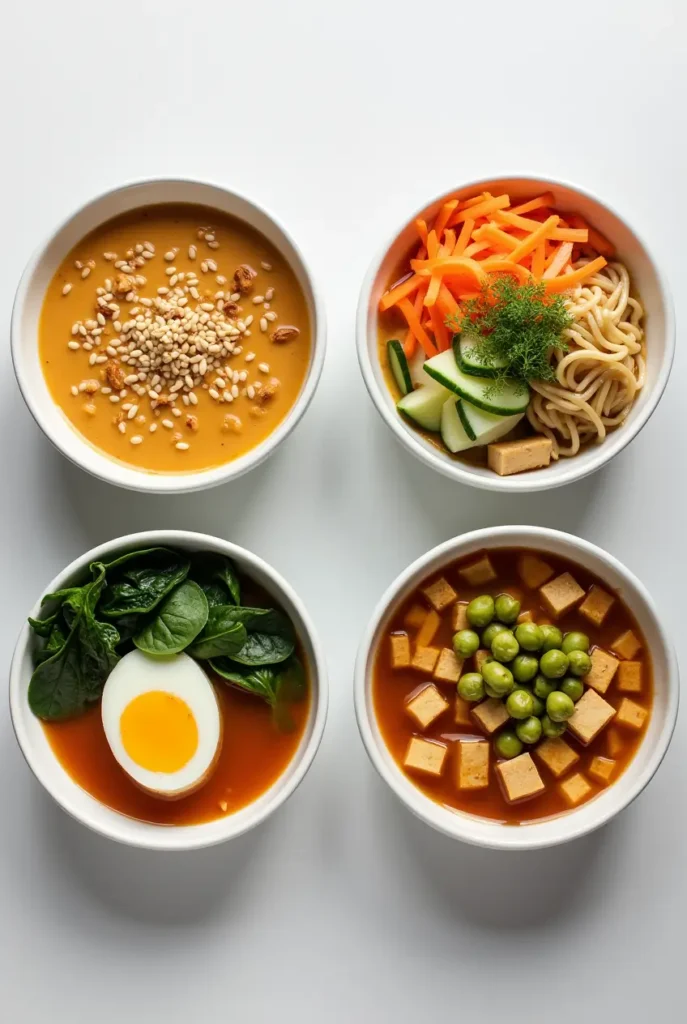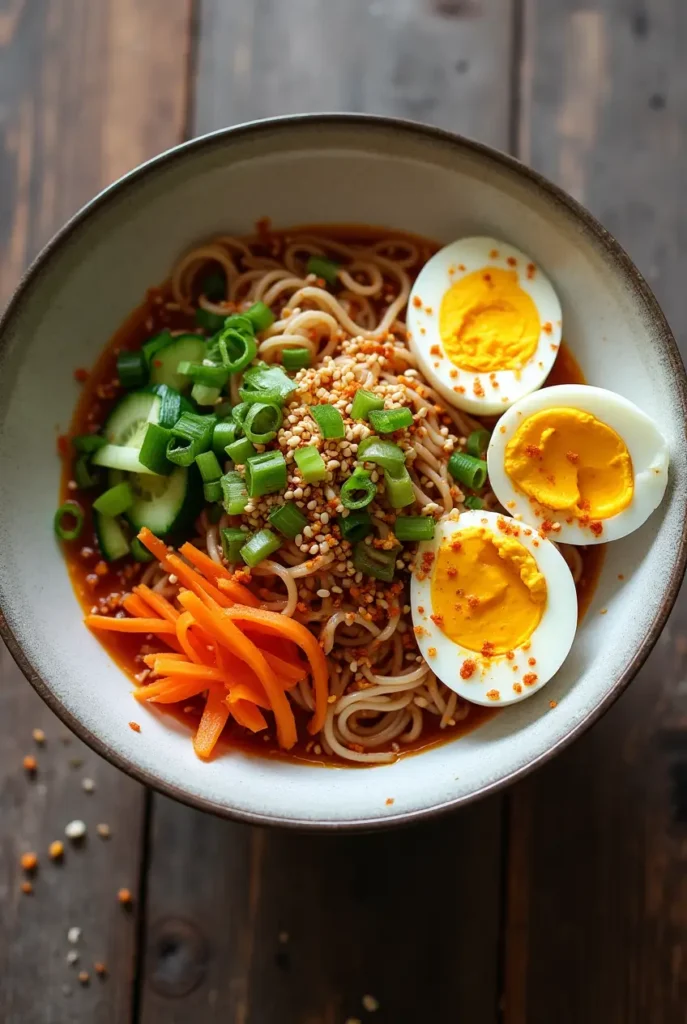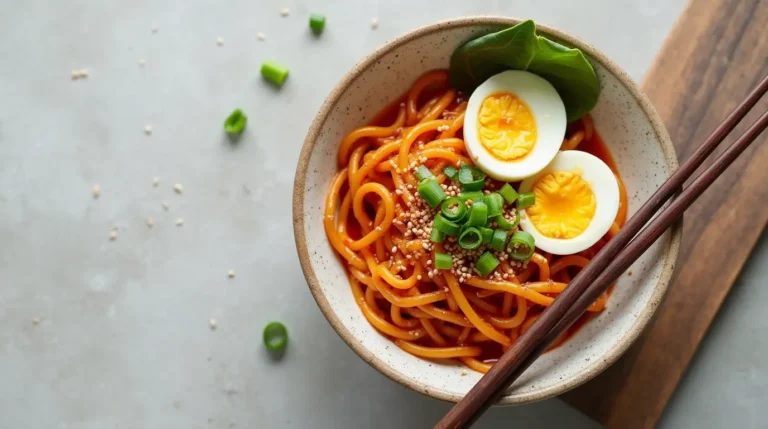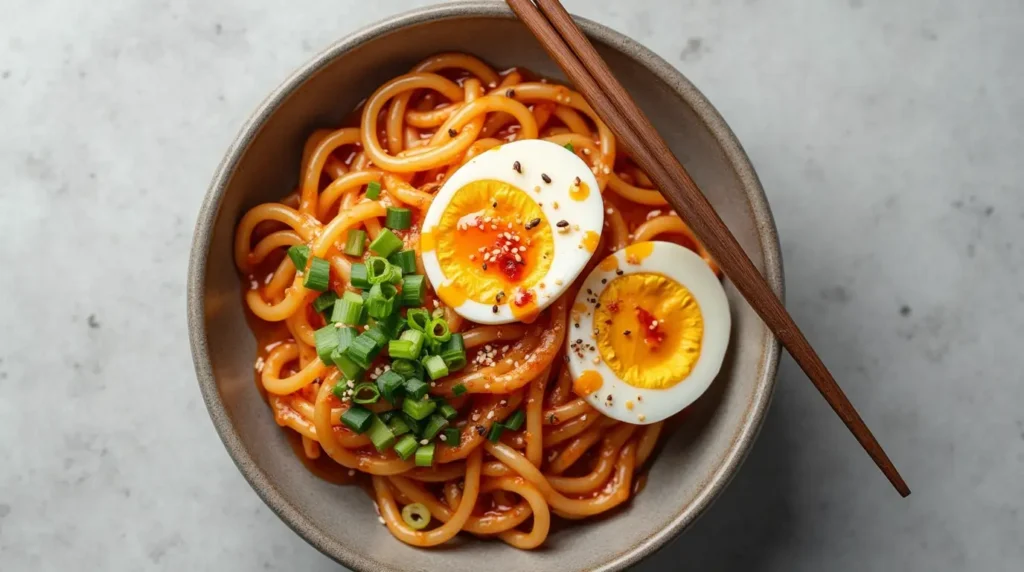Introduction to Spicy Miso Noodles
Craving something cozy, flavorful, and quick to make? Spicy Miso Noodles might just be the perfect fix. This dish blends the comforting warmth of noodles with bold, spicy, and umami-rich miso for a meal that satisfies both your cravings and your schedule. It’s the ideal choice when you’re tired of basic pasta or want something more exciting than takeout.
The beauty of Spicy Miso Noodles lies in their simplicity. With just a handful of pantry-friendly ingredients, you can whip up a restaurant-quality dish in under 20 minutes. It’s the kind of recipe that feels gourmet without the fuss. From the first bite, you’ll taste the harmony between the savory miso paste, the fiery kick of chili oil, and the silky texture of noodles—all tied together with aromatic garlic and sesame oil.
Plus, it’s endlessly customizable. Whether you’re vegan, vegetarian, or a meat-lover, you can make this dish your own with different noodles, proteins, or toppings. Think of it as your go-to weeknight comfort meal, ready to deliver on flavor, heat, and satisfaction every time.
What Are Spicy Miso Noodles?
At their heart, Spicy Miso Noodles are a celebration of bold flavor and satisfying texture. The dish centers around noodles—often ramen or udon—tossed in a sauce made from miso paste, chili oil or paste, soy sauce, garlic, and sesame oil. Each ingredient plays a vital role: the miso brings depth and umami, the chili adds spice, and the sesame oil rounds it all out with a nutty finish.
The toppings are just as important. A soft-boiled egg, scallions, toasted sesame seeds, sautéed mushrooms, or tofu can elevate your noodles into a complete and nourishing meal. You can even swap in zucchini noodles or soba for a healthier or gluten-free twist.
Unlike traditional ramen soup, Spicy Miso Noodles are often served dry or saucy, not brothy—making them easier and quicker to prepare. Still, the flavor is just as rich, if not more concentrated, allowing every strand of noodle to soak up the spicy, savory goodness.
This dish bridges the gap between global flavors and home cooking. It’s inspired by Japanese miso ramen but simplified for everyday meals without compromising taste. Whether you want a fast lunch or an easy dinner, these noodles hit the mark every time.
The History of Spicy Miso Noodles

The roots of Spicy Miso Noodles can be traced back to the rich culinary history of Japan, where miso paste has been a staple for over a thousand years. Traditionally used in soups and sauces, miso is a fermented soybean paste known for its deep umami flavor and health benefits. As Japanese cuisine spread globally, chefs and home cooks began experimenting with it in new ways.
Spicy miso ramen became particularly popular in Japan’s Hokkaido region, where miso-based broths were developed to withstand cold winters. These broths later made their way into Western food culture, especially in fusion restaurants across the U.S. and Europe. That’s where the concept of simplified, broth-free Spicy Miso Noodles took off—adapting the complex soup into a quick, flavorful dry noodle dish.
What once required hours of simmering and specialty ingredients is now something you can make in less than 20 minutes using everyday pantry staples. The modern version is a reflection of today’s food trends: fast, flavorful, and flexible. You can find countless takes on the dish across food blogs, TikTok videos, and YouTube cooking channels, each bringing its own spin to the classic base.
In many ways, the evolution of Spicy Miso Noodles mirrors that of other comfort food favorites like chicken noodle soup—deeply rooted in tradition, yet constantly reimagined.
Why You’ll Love Spicy Miso Noodles
There are so many reasons why Spicy Miso Noodles deserve a spot in your meal rotation. First, they’re lightning fast—most versions come together in under 20 minutes. For anyone juggling work, family, or school, that’s a game-changer. You get big flavor without spending hours in the kitchen.
Second, they’re highly customizable. You can tone down the spice or crank it up. Prefer soba over ramen? Go for it. Want to make it vegan or gluten-free? It’s easy to adjust. The recipe works well with plant-based proteins like tofu or tempeh, but it also pairs beautifully with chicken, shrimp, or beef.
The flavor profile is another major win. The umami-rich miso paste blends with garlic, soy sauce, and sesame oil to form a base that’s salty, savory, slightly sweet, and full of depth. Chili oil adds that satisfying heat that builds with every bite, keeping your taste buds engaged.
And let’s not forget how well these noodles reheat. Unlike many noodle dishes that fall flat the next day, Spicy Miso Noodles hold their flavor—and sometimes taste even better after the flavors have melded overnight. They’re ideal for meal prep or next-day lunches.
Whether you’re someone who loves exploring global flavors or just needs a fresh take on noodles outside of your usual pad Thai, this dish is a no-brainer.
Step-by-Step Guide to Making Spicy Miso Noodles
Crafting a rich, satisfying bowl of Spicy Miso Noodles is simpler than you might expect. Begin by cooking your preferred noodles—ramen, udon, soba, or even spaghetti all work great. While they cook, prepare a bold, umami-packed sauce by whisking together miso paste, chili oil, soy sauce, sesame oil, minced garlic, and a splash of rice vinegar. Once your noodles are done, toss them in the sauce until fully coated.
To finish, top your noodles with anything from soft-boiled eggs and tofu to sautéed mushrooms, scallions, or toasted sesame seeds. It’s a fast and flexible dish that delivers maximum flavor with minimal effort—perfect for lunch, dinner, or anytime you crave something spicy and comforting.
📌 CLICK HERE 📌 to view the full printable recipe with exact measurements and step-by-step instructions in the recipe card plugin.
Creative Variations of Spicy Miso Noodles

One of the most exciting things about Spicy Miso Noodles is just how flexible they are. You can start with the base recipe and easily transform it into something entirely new, depending on your cravings, dietary needs, or what you have in your fridge.
Creamy Spicy Miso: Add a tablespoon of peanut butter or tahini to the sauce. This adds creaminess and a nutty undertone that complements the chili and miso perfectly.
Cold Noodle Bowl: Serve the noodles chilled for a refreshing summer option. The spicy and tangy notes of the sauce really shine when the dish is served cold.
Spicy Miso Ramen Soup: Turn your noodles into a warming soup by adding vegetable or chicken broth, baby spinach, and a soft-boiled egg. This version is comforting and hearty—perfect for chilly days.
Plant-Based Protein Boost: Marinated tofu, tempeh, or edamame makes the dish filling while keeping it vegan and protein-packed.
For Meat Lovers: Add grilled chicken strips, sautéed shrimp, or stir-fried beef for extra richness and variety.
These twists are as customizable as your favorite spaghetti with marinara sauce. You can get creative with toppings, switch up the base noodles, or even blend cultures with fusion ingredients. The base flavor is bold enough to pair well with a wide range of textures and profiles, so don’t hesitate to experiment. You’ll never get bored with Spicy Miso Noodles when you know how to remix them.
How to Store and Serve Spicy Miso Noodles
Proper storage and serving can make a big difference in how your Spicy Miso Noodles taste the next day. Whether you’re making a big batch for meal prep or just storing leftovers, keeping the flavor and texture intact is simple with a few smart steps.
Storing Tips:
Let the noodles cool completely before transferring them to an airtight container. Store in the fridge for up to 3 days. The sauce may thicken slightly in the fridge, which is normal.
Reheating Tips:
You can reheat in a microwave or on the stovetop. Add a splash of water or broth to loosen the sauce and help it return to its original consistency. Stir frequently to make sure the heat distributes evenly.
Serving Suggestions:
To freshen up leftovers, top the reheated noodles with a drizzle of chili oil, a sprinkle of sesame seeds, or freshly chopped scallions. A soft-boiled egg, steamed greens, or a crisp side salad can complete the plate and make it feel like a brand-new meal.
These noodles hold up just as well as spaghetti carbonara, but they do benefit from a little extra moisture when reheating. You’ll be amazed at how delicious they still are on day two—possibly even better than the first time around as the flavors continue to develop.
Tips for the Perfect Spicy Miso Noodles
To elevate your Spicy Miso Noodles to restaurant-level quality, a few expert tips can go a long way. While the recipe is beginner-friendly, a few tweaks and small details can really enhance the flavor and texture.
Choose the Right Miso: Red miso brings a strong, salty, and bold taste, while white miso is milder and slightly sweet. Choose based on your desired flavor depth.
Balance the Sauce: Use rice vinegar or lime juice to balance the richness of the miso and oil. This brings brightness and complexity.
Spice Level Control: Always start with less chili oil and adjust gradually. You can add more, but you can’t take it out once it’s too spicy.
Al Dente is Best: Slightly undercooked noodles will continue to soften as they absorb the sauce. This keeps the texture springy and satisfying.
Finish Strong: Garnish with green onions, sesame seeds, or crispy garlic for added texture and flavor contrast.
If you’re looking to lighten up the dish, you can even swap traditional noodles for veggie-based alternatives like zucchini noodles with avocado pesto. They provide a fresh, low-carb base that still soaks up all that spicy miso goodness.
With these tips, you’ll turn your simple noodle dish into a flavor-packed experience every time.
Common Mistakes to Avoid When Making Spicy Miso Noodles
Even the easiest recipes come with their pitfalls, and Spicy Miso Noodles are no exception. Avoiding a few common mistakes will help ensure your dish turns out flavorful, balanced, and satisfying—every single time.
Too Much Miso: Miso is powerful. Overusing it can result in an overwhelmingly salty and dense sauce. Start with less and build up if needed.
Burning Garlic: Garlic burns quickly, especially in oil. Add it toward the end of cooking your sauce or sauté on low heat to keep the flavor sweet and aromatic.
Poor Sauce Texture: Not whisking the sauce well leads to uneven flavor. Combine your miso, soy, chili oil, and other ingredients thoroughly before adding to noodles.
Wrong Noodle Choice: Some noodles absorb sauce better than others. Ramen, udon, or soba are ideal. Thin noodles may break or become mushy.
Skipping the Taste Test: Always taste your sauce before combining it with the noodles. Adjust the salt, spice, and acidity so it’s perfectly balanced.
Think of it like prepping a reliable bowl of chicken noodle soup: it’s simple, but small mistakes can throw off the final result. Get these basics right, and you’ll have the perfect spicy miso dish every time.
Decorating Ideas for Spicy Miso Noodles

A great dish isn’t just about flavor—it’s about presentation, too. With just a few simple garnishes, you can transform your Spicy Miso Noodles from a quick meal into an Instagram-worthy bowl that looks as good as it tastes.
Here are some easy ways to dress up your noodles:
Soft-Boiled Eggs: A ramen-style soft-boiled egg sliced in half adds visual appeal and a rich, creamy yolk that pairs beautifully with the spicy sauce.
Fresh Scallions or Microgreens: Sprinkle chopped scallions or microgreens over the top for a pop of color and a hint of fresh, peppery crunch.
Chili or Sesame Oil Drizzle: A glossy swirl of chili oil gives your dish that restaurant-style finish and a boost of extra heat. Sesame oil adds a nutty aroma that complements the miso.
Toasted Sesame Seeds: These not only add texture and flavor but also create an elegant contrast against the noodles.
Julienned Vegetables: Thin slices of cucumber, carrot, or radish bring brightness and a refreshing crunch to balance the rich miso base.
Plating also matters. Use a wide, shallow bowl to spread out your noodles and toppings. Layer each element with intention so the colors and textures shine through. This kind of thoughtful presentation turns your Spicy Miso Noodles into more than just a meal—it becomes an experience.
FAQs About Spicy Miso Noodles
If you’re new to making Spicy Miso Noodles or just curious about some common tweaks, these frequently asked questions should help:
Are Spicy Miso Noodles gluten-free?
They can be! Just use gluten-free noodles like rice or buckwheat soba and replace regular soy sauce with gluten-free tamari or coconut aminos.
Is this recipe vegan?
Absolutely. Skip the egg and stick to plant-based toppings like tofu, mushrooms, or edamame. Miso paste is typically vegan, but always check the label just to be sure.
Can I make it less spicy?
Yes. Start with half the chili oil or paste and add more gradually. You can also balance the heat with a bit of sweetness like maple syrup or honey (if not vegan).
Can I turn it into soup?
Definitely. Add a few cups of vegetable or chicken broth to the sauce and toss in some greens or mushrooms to create a spicy miso ramen-style soup.
What noodles work best?
Ramen, udon, and soba are traditional favorites. However, even spaghetti, rice noodles, or pad Thai noodles can work in a pinch.
Whatever your preferences, Spicy Miso Noodles can easily adapt to suit your taste or dietary needs.
Conclusion
Whether you’re cooking for one, meal prepping for the week, or whipping up something quick after a long day, Spicy Miso Noodles deliver bold flavor with minimal effort. Their deep umami richness, the kick of spice, and the endless ways to customize them make this dish a true weeknight hero.
From creamy miso twists to refreshing cold bowls, there’s no shortage of ways to enjoy this versatile recipe. Plus, with easy swaps and dietary options, everyone at the table can dig in—vegan or not, spicy-lover or mild-only.
And if you’re craving more noodle inspiration, head over to some fantastic recipe hubs like NYT Cooking, AllRecipes, and Tasty. You’ll find tons of ideas that pair perfectly with your next batch of Spicy Miso Noodles.
So go ahead—boil those noodles, whip up that sauce, and dive into the spicy, savory goodness tonight. Your taste buds will thank you.
Print
Spicy Miso Noodles: 5 Easy Steps to a Bold Flavor Kick
These Spicy Miso Noodles are bold, savory, and satisfying. Ready in just 15 minutes, this easy dinner recipe features noodles tossed in a rich, umami-packed miso sauce with a kick of chili heat. Topped with soft-boiled eggs, scallions, and sesame seeds, it’s a comforting and customizable dish perfect for any night of the week.
- Total Time: 15 minutes
- Yield: 2 servings
Ingredients
200g (7 oz) ramen, udon, soba, or spaghetti noodles
2 tbsp miso paste (red for bold flavor, white for milder)
1 tbsp soy sauce
1 tbsp chili oil or chili garlic paste (adjust to taste)
1 tsp sesame oil
1 tsp rice vinegar
2 cloves garlic, finely minced
Optional toppings:
Soft-boiled eggs (halved)
Chopped green onions (scallions)
Toasted sesame seeds
Sautéed mushrooms
Tofu, edamame, or vegetables of choice
Instructions
Cook the noodles according to package instructions. Drain and set aside.
In a bowl, whisk together miso paste, soy sauce, chili oil, sesame oil, rice vinegar, and minced garlic until smooth.
In a pan (optional): sauté tofu, mushrooms, or vegetables if desired.
Toss the noodles with the sauce until evenly coated.
Serve hot, topped with eggs, scallions, sesame seeds, or any preferred garnish.
Notes
Adjust chili oil based on spice tolerance.
Red miso has a stronger, saltier flavor; white miso is milder and slightly sweeter.
For a soupier version, add 1–2 cups of vegetable or chicken broth.
Great for meal prep—store in an airtight container for up to 3 days.
- Prep Time: 5 minutes
- Cook Time: 10 minutes
- Category: Dinner
- Method: Stovetop
- Cuisine: Asian-Inspired / Japanese-Inspired
- Diet: Vegetarian
Nutrition
- Serving Size: 1 bowl (½ recipe)
- Calories: 480 kcal
- Sugar: 3g
- Sodium: 1120 mg
- Fat: 18g
- Saturated Fat: 2.5 g
- Unsaturated Fat: 14 g
- Trans Fat: 0g
- Carbohydrates: 60 g
- Fiber: 4g
- Protein: 12g
- Cholesterol: 90 mg (from egg; omit for vegan)



